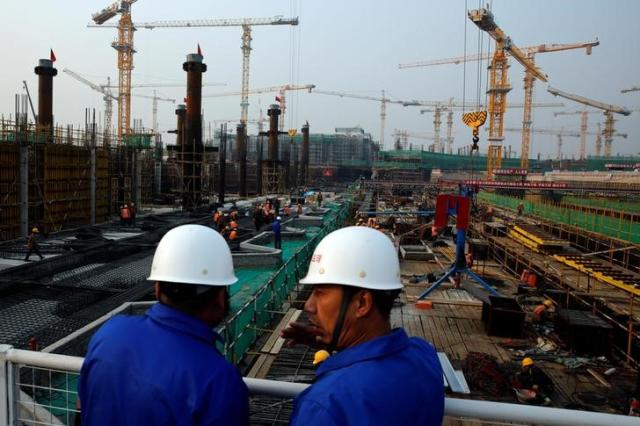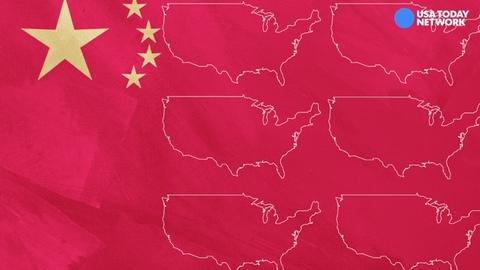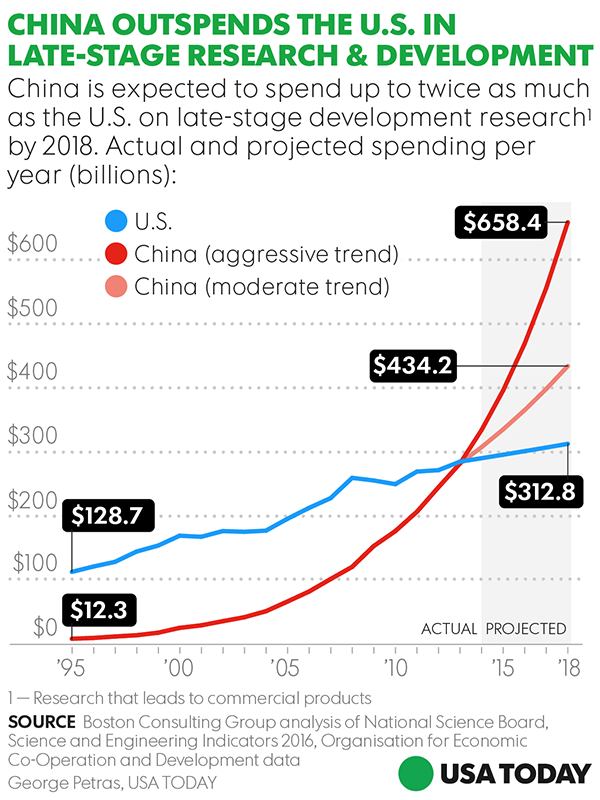antiterror13
Brigadier
Wake me up IF that happens.
are you having looong sleep?
Wake me up IF that happens.

Come on guys lets go back to economy
All the skeptic are wrong China keep growing
China first-quarter GDP grows faster than expected 6.9 pct, steel output hits record

By Kevin Yao.......snip
Not unless PRC plans to dump more steel here. That son of a bitch Robert Shitzinger better be ready to deal with it.Wrong thread.
SorryWrong thread.



They will soon starved of talent as living standard improve in China and the economy moved the ladder China need their own talent combined with bamboo ceiling and restriction of visa. there is just no choice but to go home
China's 'Best And Brightest' Leaving U.S. Universities And Returning Home
,

For thousands of Chinese teens flocking to American colleges, the pursuit of the American dream is often dependent on the H1-B visa. (Photo by FREDERIC J. BROWN/AFP/Getty Images)
Chinese college students studying in the U.S. are finding it just as interesting these days to return home to the world's No. 2 economy rather than staying a few years in the world's No. 1.
Some 82.23% of students who studied abroad returned to China last year, up from 72.38% in 2012, according to government figures.
China's 21st Century Education Research Institute said foreign countries’ job markets could not accommodate the surge in Chinese students. It wasn't just Chinese studying in their preferred country -- the United States -- but also included students that were studying in New Zealand and Australia as well. National Institute of Education Sciences researcher Chu Chaohui said returning students had more resources and better networks in China to find a job, while Chinese students in the U.S. were dependent on 20,000 H1-B visas for tens of thousands of students, not only from China, and the majority of them working in computer sciences.
Most wealthy Chinese that buy real estate in the U.S. are buying properties for their children to live in during their college years. In fact, college is the number one driver of Chinese real estate sales here. But as this market gets more saturated, and as China's economy becomes more entrepreneurial, students are finding the market to be just as welcoming to them there. Having a U.S. diploma helps.
Sorry
Here is why American economy is stagnant It has nothing to do with China stealing job from US and more to do with short term planning of american economy. They are obsessed with quarterly report and missed the big picture. And stop accusing China of stealing technology. You just can;t prevent you competitor from copying Do better job at long range planning and invest in people and technology
Why China is beating the U.S. at innovation
, USA TODAYPublished 8:23 a.m. ET April 17, 2017 | Updated 11 minutes ago
Why China is beating the U.S. at innovation
Why China is beating the U.S. at innovatio...
CLOSE

China is surpassing the U.S. in new product research and development. Could this have an impact on the U.S. economy? USA TODAY
20COMMENTEMAILMORE
For decades, America lost factories and jobs to China but retained a coveted title: the world's leader in inventing and commercializing new products.
Now, even that status has been eroded, and it's hurting the economy .
While the United States is still at the top in total investment in research and development — spending $500 billion in 2015 — has made a startling finding: A couple of years ago, China quietly surpassed the U.S. in spending on the later stage of R&D that turns discoveries into commercial products. And at its current rate of spending, China will invest up to twice as much as the U.S., or $658 billion, by 2018 on this critical late-stage research.
In other words, the U.S. Is doing the hard work of inventing new technologies, and China, among other countries, is reaping the benefits by taking those ideas and turning them into commercial products,the report says.
“Other countries are free-riding on the U.S. investment," says Justin Rose, who co-authored the BCG study.

The slippage is a significant blow for the U.S. economy, costing the country tens of billions of dollars a year in manufacturing output and hundreds of thousands of factory jobs over the past decade or so, BCG says. Companies that lead in commercializing ideas also typically build factories near their research centers so scientists can test products before making them.
The burgeoning commercial drone market is a prime example of the shift. The U.S. military developed drone technology throughout the 20th Century for reconnaissance and other purposes, adding microchips for better wireless control and longer-lasting batteries. But China’s Da-Jiang Innovations has refined the unmanned vehicles to better avoid obstacles and has become the world’s largest builder of commercial drones. It sells them to U.S. real estate and construction firms for applications such as aerial photography and mapping. DJI has three factories in Shenzhen.
The U.S. has also given birth to a Smithsonian-worthy collection of breakthrough technologies -- including flat-panel displays, digital mobile handsets, notebook computers and solar panels — only to fumble away their development to other countries, particularly China and Japan.
The BCG study concludes the U.S. has the potential to reverse the trend through better collaboration among private industry, universities and research consortia. Such a shift would increase annual manufacturing output by 5%, or $100 billion, and add 700,000 factory jobs and another 1.9 million in other sectors through ripple effects.
Yet while President Trump is focused on narrowing the nation’s trade deficit, his proposed budget would slash federal funding for R&D, potentially snuffing out a significant source of U.S. manufacturing jobs that could help accomplish that goal. Last year, the U.S. had an $83 billion trade gap in advanced technology products, according to the Census Bureau.
The country is still the global leader in “basic and applied” R&D, which makes early discoveries and further refines them. About a third of the $500 billion the country spends on R&D is funneled to those activities. But while two-thirds of the total goes to later-stage “development” R&D, China invests 84% of its R&D money on advances that yield commercial products. For the past decade, “development” R&D has been growing 20% a year in China, versus 5% in the U.S., the BCG report says. As recently as 2004, the U.S. spent four times as much as China.
In China, many technology companies are state-owned and so they don’t have to worry if massive R&D spending yields losses until a product is commercialized, and even the research of private firms is often subsidized by the government, says Robert Atkinson, president of the Information Technology and Innovation Foundation. The Chinese government, he says, also gives the private sector specific timetables for achieving dominance in areas such as solar, printers, robots and drones. And China routinely steals technology and fails to enforce patent laws, Atkinson says
“They have huge advantages,” he says.
There’s ample opportunity for a U.S. turnaround, BCG says, with 75 of the world’s 200 highest-rated universities located in the U.S. But there’s little cooperation among the schools, which do the lion’s share of basic and applied research, largely through federal grants, and private companies, which do most of the development research.
The Study:
Among the obstacles BCG identified:
• Schools do a poor job of promoting their latest research and putting it in a digestible form for manufacturers. And researchers are focused on securing tenure, while companies are seeking a return on their investment. When companies do partner with universities, it’s often for a limited, product-specific purpose rather than for developing industrywide solutions that take longer to bring to fruition but can create many more jobs.
“Companies are being gun-shy and risk-averse and not wanting to make big bets on transformative technology,” Atkinson says. Instead, the're focused on quarterly profits, which typically determine executives' bonuses.
• U.S. manufacturers are reluctant to collaborate with other companies because they don't want to share the fruits of their research with competitors.
• Manufacturers are reluctant to work with suppliers to establish industrywide standards that can reduce costs and speed implementation of technologies, fearing the suppliers would share the information with competitors.
The study says the government should set up a central repository for federally- funded university research; school research should be geared toward commercializing products; manufacturers should build long-term relationships with universities, such as Procter & Gamble’s link-up with the University of Cincinnati; and public-private research consortia should focus on developing industrywide solutions. Since 2008, P&G has invested millions of dollars in a university computer simulation center to enhance its consumer household products, their packaging and manufacturing processes.
“If we want to be the leader in product development for things that matter in people’s lives, pushing money into developing important (products) is what we should be focused on,” BCG’s Rose says.
I agree unskilled labor would decline, but I'm not so sure the immigration decline of educated or people with means would be worse under Trump than some other President. We'll still get the lion share of the world's best to immigrate (hooray!), but that growth was already flattening before Trump became President.Trump era are proof that the brain drain in America will only get worse.
I agree unskilled labor would decline, but I'm not so sure the immigration decline of educated or people with means would be worse under Trump than some other President. We'll still get the lion share of the world's best to immigrate (hooray!), but that growth was already flattening before Trump became President.
